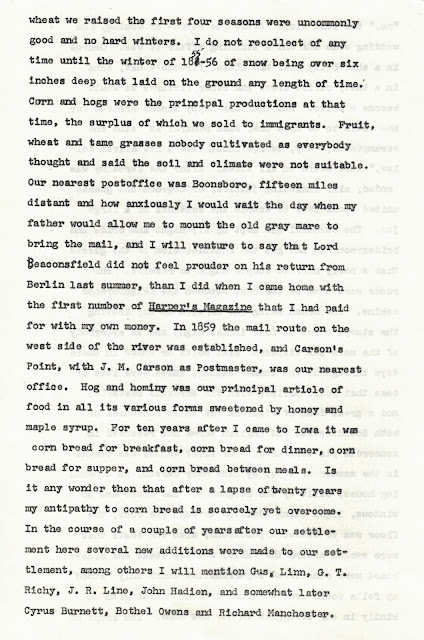A few days ago I posted the first of two parts that give us a look at how our ancestors lived in the early 1850's in Iowa. Daniel Peterson certainly had a way with words, adding details and the flowery language of the day.
I'm so glad to know that several of you are enjoying his writings and remembrances and have contacted me. I received an important question this week that I'd like to answer for everyone.
Since John Linn and his wife Brita came with a group that included Andrew Peterson and his family, why in the first part of this post did Andrew need to travel north 25 miles to see his old friend John Linn?
It's true that Andrew Peterson and John Linn traveled together from Sweden to Iowa. I have ship records and moving out records and, of course, Daniel Peterson's story to verify this. Normally, immigrants settled close to one another. They needed each other to help build their homes, to translate for others and conduct business, for safety, to worship, and more.
It's clear from Daniel's writing that John Linn traveled farther north to settle and that Andrew Peterson brought his family up two years later. I have no answer for why. Did John strike out on his own? Did the group split into two or more smaller groups to settle? Did Andrew need to stay behind because of any health issues or to greet other new immigrants?
Twenty-five miles today seems like nothing and, indeed, these two families did live in the same county. But this two-day trek for the Petersons might have meant that the Petersons longed for more Swedish community around them or more help on a regular basis.
When I received this question, I re-read the first portion of Daniel's writing to see if a reason was given, but I found nothing. Next, I went to the 1850 US Federal State Censuses. And there I do find John and Mary Lynn (sic) living in Boone County in dwelling 830, and family 858. I'm sure that the reason the dwelling numbers and family numbers don't match is that a dwelling might hold several families in this new state.
I also found Andrew Peterson's family living in Boone County, but in dwelling 760, family 786.
How far apart these two families were is unknown as I cannot locate any document that tells HOW, or IN WHAT ORDER, the census was taken. The two pages of the census were taken 5 days apart. Both were taken by Assistant Marshal, Peter Myers. None of this helps determine the WHY for the initial settling of John Linn and Andrew Peterson, but I hope it helps a bit.
One thing I've learned about genealogy is that every answer leads to more questions!!
You also would have read that Andrew Peterson purchased the claim of Pleasant Chitwood and may have wondered about this name. Mr. Chitwood was born in Tennessee and came to Iowa sometime in the 1840's. In 1848, he took a claim in Pilot Mound Township in Boone County and hired a man named Thomas Sparks to clear the prairie land. In taking his family across the river to this land, both he and his wife nearly drowned. It's this land that I believe Andrew Peterson purchased. Chitwood later was the sheriff of Boone County. (History of Boone County, Iowa, Vol. 1, Nathan Edward Goldthwait, p. 276-277)
In a few days, I'll post the rest of Daniel's remembrances of early life in Iowa.
























